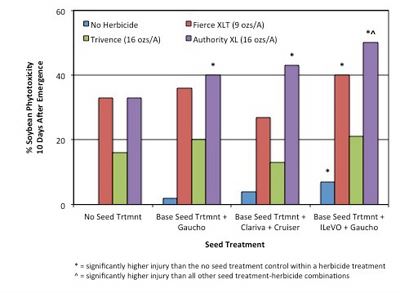Soybean Seed Treatments And Pre-Emergence Herbicides
DR. KEVIN BRADLEY
COLUMBIA, MO.
I have received numerous calls and questions over the past week about the potential interactions that may exist between soybean seed treatments and pre-emergence herbicides. Most often, the question being asked is whether the ILeVO seed treatment in some way interacts with Authority (sulfentrazone) herbicides and results in more soybean injury than what might normally have occurred had the soybean been treated with some other seed treatment. We initiated a field study this year that should eventually provide some answers to this question. I want to emphasize that ordinarily, I would not share data that is this “new” and from only one location in one year, but since I have received so many questions about this issue, I thought it might be worthwhile to share what we have learned thus far. It is important to note that a more comprehensive discussion of this issue and data, including yield, from one complete season of field research has recently been published by Dr. Kiersten Wise at Purdue University here: http://extension.entm.purdue.edu/pestcrop/2015/Issue8/ .
The objectives of our study are to: 1) determine if there are any interactions between certain seed treatments and pre-emergence herbicides, and 2) determine to what degree early-season soybean injury might correlate with yield loss, if any. In order to accomplish this, we decided to put as much stress on the soybean seedlings as we could, so we applied 2X rates (twice the normal use rate) of Fierce XLT, Trivence, and Authority XL, and we planted as early as we could under cool, wet conditions. Within a given soybean variety, we evaluated 3 different common soybean seed treatments in comparison to seed that had no seed treatment at all. Although we will be gathering a variety of information such as stand counts, height reduction, biomass reduction, and ultimately yield in response to each treatment, for the purposes of this article we are only going to share our visual soybean phytotoxicity ratings which we conducted 10 days after soybean emergence.
As you can see in Figure 1, we achieved our desired objective of stressing the soybean seedlings! Keep in mind that these levels of visual soybean injury would not normally be encountered with labeled rates of these herbicides, but these are 2X rates applied under very stressful conditions. So far, our results appear to indicate that the ILeVO seed treatment does result in more phytotoxicity to soybean seedlings than the comparison treatments of Gaucho, Clariva + Cruiser, and non-treated seed when used in combination with certain pre-emergence herbicides like Authority XL. Our results also indicated a higher level of phytotoxicity from the ILeVO seed treatment and Fierce XLT combination, but there was no interaction with Trivence.
For the most part, our results are consistent with what Dr. Wise reported in her study at Purdue. It is important to note that in the Purdue study, the authors reported no effect on soybean stand density and no yield reductions as a result of ILeVO seed treatment. From our perspective, we still have much to learn about these potential interactions and we will be gathering much more data throughout the season. It remains to be seen if these levels of early-season injury will correlate to any significant degree of soybean stand loss or yield reduction. ∆
DR. KEVIN BRADLEY: Associate Professor, Division of Plant Sciences, University of Missouri
